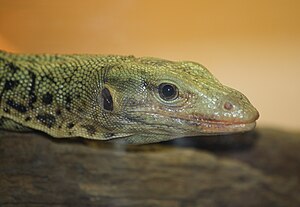Quince monitor
| Quince monitor | ||||||||||||
|---|---|---|---|---|---|---|---|---|---|---|---|---|

Quince monitor ( Varanus melinus ) |
||||||||||||
| Systematics | ||||||||||||
|
||||||||||||
| Scientific name | ||||||||||||
| Varanus melinus | ||||||||||||
| Böhme & Ziegler , 1997 |
The quince monitor ( Varanus melinus ) is a species of the scale crawfish (Squamata) from the genus of monitor lizards ( Varanus ). The specific epithet melinus , Latin adjective for pale yellow, refers to the characteristic yellow basic color.
features
The quince monitor is a medium-sized, slim monitor. Paratype 1, a male, is given a total length of 115 cm with a head-trunk length of 42 cm, two and a half years later the animal reached 120 cm. For the largest female, a total length of 95 cm is given. Bayless and Adragna name a maximum length of 120 to 150 cm. For a young animal that has just hatched, a total length of 21.6 cm and a weight of 22 g is given.
Characteristic of the quince monitor is the intense yellow basic color of the head, neck, body, limbs and tail base. Dorsally there is a dark, net-like markings, mainly on the body, but also on the neck, the limbs and the base of the tail, more or less strongly present. The drawing fades into yellow with age. The tail is usually banded black and yellow across. The tongue is evenly pink. Young animals are blackish in color with light to yellow markings. This pattern is formed by transverse rows of eye spots (ocelli). Later, beginning with the head and neck, the color changes into the typical yellow of the subadult and adult animals.
Diffusion and protection
The quince monitor occurs on the Sula Islands Mangole and Taliabu , which belong to the Indonesian island group of the Moluccas . An occurrence on Banggai has not yet been confirmed, sometimes Sanana is still called. The supposed type locality Obi only turned out to be a place of middleman. Other areas of origin are uncertain, as animal trappers are reluctant to name exact collection areas and thus incorrect or incomplete locations are communicated to exporters.
It is not protected in Indonesia and is not on the Red List of Endangered Species , but is classified as threatened by the WWF, for example . The quince monitor is covered by the Washington Convention on the Protection of Species (CITES) in Appendix II . A transfer to Appendix I and thus a ban on commercial trade for wild-caught fish is still pending due to insufficient data. According to a local reptile hunter, the wildlife population has declined sharply since commercial trade began. According to this source, 10,000 quince monitors have already been removed, a clear contradiction to the low number of official wild-caught animals.
Habitat and way of life
According to Bayless and Adragna, quince monitors live in the interior of the tropical lowland forests of Taliabu, which are characterized by dense stands of two-winged fruit trees. According to Lemm, the animals are shy and prefer hiding under moss or wood or high in the trees. They don't seem to like bright light without shady vegetation. While Böhme and Ziegler (1997) recognize a tendency to activity at dawn and dusk, Dedlmar and Böhme (2000) report daytime activity preferentially in the early morning hours. The activity phase is short, Bayless and Adragna report from 45 to 120 minutes, especially from dusk to sunset.
In captivity , the quince monitor shows a clear predilection for high levels of moisture and water. The willingness to swim and dive suggests that the species probably inhabits swamps or similar habitats. In addition, its sharp claws and tail that can be grasped make it a good climber. Like almost all other monitor lizards, the quince monitor is a carnivore .
Systematics
The species was first scientifically described in 1997 by the biologists Wolfgang Böhme and Thomas Ziegler . The male holotype is kept in the Koenig Museum in Bonn . The type locality Obi ( Moluccas ), which is based on a traded animal, was corrected by Böhme and Ziegler to the Sula Islands , since Obi is only an intermediate station in the trade with the species. Based on the genital morphology , the quince monitor is assigned to the subgenus Euprepiosaurus within the Varanus indicus group.
Individual evidence
- ↑ a b Wolfgang Böhme, Thomas Ziegler: Varanus melinus sp. n., a new monitor lizard from the V. indicus group from the Moluccas, Indonesia. Herpetofauna (111), 1997; Pp. 26-34.
- ↑ a b c d e f g Eric R. Pianka, Dennis King, Ruth Allen King: Varanoid Lizards of the World. Indiana University Press, 2004, ISBN 978-0253343666 , pp. 215-218.
- ↑ Quince monitor. (PDF) In: wwf.de ( TRAFFIC ). April 2010, accessed February 10, 2016 .
- ↑ a b c A. Koch, T. Ziegler, W. Böhme, E. Arida, M. Auliya: Pressing Problems: Distribution, threats, and conservation status of the monitor lizards (Varanidae: Varanus spp.) Of Southeast Asia and the Indo-Australian Archipelago. In: Herpetological Conservation and Biology 8 (Monograph 3), 2013, pp. 19-20. ( Online )
- ↑ Quince monitor. In: wwf.de. Retrieved February 10, 2016 .